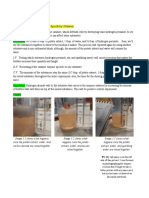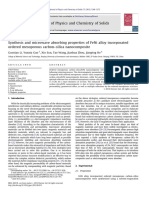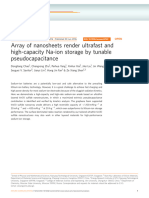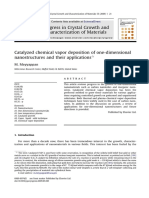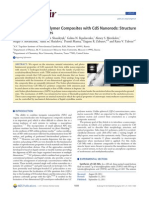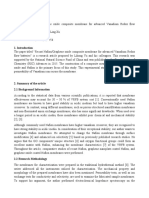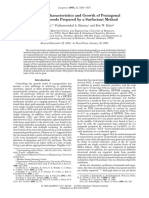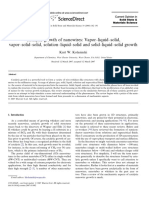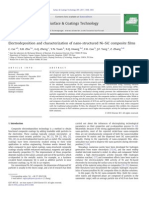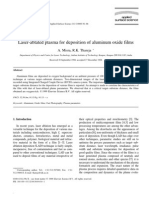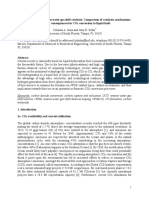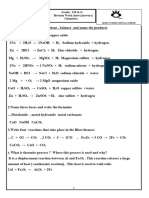Hierarchical Architecture of Self-Assembled Carbon Nitride Nanocrystals (
Hierarchical Architecture of Self-Assembled Carbon Nitride Nanocrystals (
Uploaded by
emmstark009Copyright:
Available Formats
Hierarchical Architecture of Self-Assembled Carbon Nitride Nanocrystals (
Hierarchical Architecture of Self-Assembled Carbon Nitride Nanocrystals (
Uploaded by
emmstark009Original Description:
Original Title
Copyright
Available Formats
Share this document
Did you find this document useful?
Is this content inappropriate?
Copyright:
Available Formats
Hierarchical Architecture of Self-Assembled Carbon Nitride Nanocrystals (
Hierarchical Architecture of Self-Assembled Carbon Nitride Nanocrystals (
Uploaded by
emmstark009Copyright:
Available Formats
View Article Online / Journal Homepage / Table of Contents for this issue
COMMUNICATION
www.rsc.org/materials | Journal of Materials Chemistry
Hierarchical architecture of self-assembled carbon nitride
nanocrystals{
Published on 05 March 2007. Downloaded by University of California - Riverside on 17/03/2014 21:43:42.
Li Yang,*a Paul W. May,a YiZhong Huangb and Lei Yinc
Received 7th February 2007, Accepted 26th February 2007
First published as an Advance Article on the web 5th March 2007
DOI: 10.1039/b701914a
A range of complex nanostructures have been observed
by the self-assembly of carbon nitride nanocrystals, which
involved an increase of the structural complexity from
0D A 1D A 2D A 3D evolution.
Over the past decade, self-assembly and alignment of nanostructured materials have been widely investigated.1 It is believed that
the ability of nanostructures to self-assemble in this manner
provides potential building blocks for microscale or nanoscale
devices. Many types of inorganic nanoparticles have been investigated, including metals, metal oxides, and other semiconductors.
These inorganic nanocrystals self-assemble into a range of structures, such as compact hexagonal networks, rings, strips, tubes,
columns and labyrinths.2 For example, ZnO forms micron- and
submicron-scale dandelion-like structures, which are comprised
of single-crystalline building units (either nanorods (NRs) or
nanoparticles (NPs)),3 and which can be constructed via a modified
Kirkendall process in solution, where the pre-formed oxide layer
serves as a shell template for the initial nucleation and growth.
Also, uniform Sb2S3 nanorod bundles have been synthesized on a
large scale using a hydrothermal technique, at a temperature of
180 uC for 20 h.4
However, to date, there has been little effort devoted toward the
understanding of the self-assembly processes of Group IVV
compounds, such as carbon nitride. Carbon nitride has been the
subject of numerous publications since the prediction by Liu and
Cohen5 in 1989 that crystalline C3N4 should have superhard
properties. However, successful synthesis of bulk amounts of this
material still remains a challenge. The synthesis difficulties are
due to its low thermodynamic stability and complex bonding
environment. Recently Li and co-workers6 demonstrated a range
of self-assembled carbon nitride morphologies (including nanotube
bundles, aligned nanoribbons and microspheres) can be prepared
by a solvothermal technique. Also, our recent findings7 indicated
that the instantaneous high temperature, high pressure and high
density conditions that arise when a high-intensity focused laser
beam impinges upon a graphite target confined by a thin layer of
liquid ammonia can promote growth of crystalline carbon nitride
nanoparticles. In this communication, we will demonstrate a
a
School of Chemistry, University of Bristol, Cantocks Close, Bristol,
UK BS8 1TS. E-mail: Li.Yang@bristol.ac.uk; Fax: +44-117-925-0612;
Tel: +44-117-33-17555
b
Department of Materials, University of Oxford, Oxford, UK OX1 3PH
c
Department of Aerospace Engineering, University of Bristol, Queens
Building, University Walk, Bristol, UK BS8 1TR
{ Electronic supplementary information (ESI) available: a wavelengthdispersed optical emission spectrum of the plume accompanying the laser
ablation process. See DOI: 10.1039/b701914a
This journal is The Royal Society of Chemistry 2007
successful synthesis of carbon nitride hierarchical nanostructures
via liquid phase pulsed laser ablation (LP-PLA), whereby the
nanocrystals self-assemble into complex three-dimensional (3D)
superstructures. Fabrication of these 3D carbon nitride structures
from small building blocks via self-organization suggests that
LP-PLA may be a brute force method of synthesizing novel
materials that have hitherto been inaccessible using milder, more
conventional techniques.
The nanostructures were prepared via a LP-PLA system detailed
elsewhere.7a Briefly, a solid graphite target was placed in a sealed
stainless steel cell at room temperature containing 35 ml of
2535% ammonia solution (about 510 mm liquid layer). The laser
beam (Nd : YAG, 532 nm, pulse duration 15 ns, operating at
10 Hz, fluence 50125 mJ pulse21) was directed by a prism and
then focused using a 25 mm focal-length lens through a quartz
window in the top wall of the cell, then through ammonia to form
a y0.5 mm diameter spot on the surface of the graphite target.
Optical emission spectroscopy (OES) was used to monitor the
composition of the plasma accompanying the LP-PLA process
(see ref. 7(d) for further details). Following ablation for 0.510 h,
a suspension containing a mixture of unreacted graphite and
ablation product, both in the form of NPs, remained in the cell.
This suspension changed from colourless, to pale brown (2 h), and
then dark brown (5 h), dependent on the ablation time, indicating
an increase in solid product and/or a change in composition of the
solid due to prolonged interaction with the laser. The suspension
was stable, with no precipitate being observed for months or even
longer. The graphite sediments were filtered and removed as much
as possible by boiling with 70% perchloric acid before further
characterization.
For materials analysis, the suspension was pipetted onto a
silicon wafer or TEM grid, and then allowed to dry in air or in a
sealed tube. This procedure allowed the time taken to evaporate
the liquid to be controlled. The product was characterized using
X-ray diffraction (XRD, Bruker-AXS D8 Powder Diffractometer,
Cu Ka radiation), field emission scanning electron microscopy
(FE-SEM, JEOL 6300 F), transmission electron microscopy
(TEM, JEOL 1200 EX, 120 kV), high-resolution (HR) TEM
(JEOL 3000 F, 300 kV), energy-dispersive X-ray analysis (EDX)
and micro-diffraction analysis (MDA).
It was found that the size and morphology of the ablation
products were a complicated function of laser power, ablation
time, ammonia concentration and drying time. Four main classes
of structure are identified in the ablation product, categorised
based upon their shape and size. The first of these were irregular,
but roughly spherical NPs which were found in large quantities
after every experiment (Fig. 1a). They have been identified as
crystalline carbon nitride7 and are about 10 nm in diameter. The
J. Mater. Chem., 2007, 17, 12551257 | 1255
Published on 05 March 2007. Downloaded by University of California - Riverside on 17/03/2014 21:43:42.
View Article Online
Fig. 1 (a) Dense clumps of NPs deposited on the Si substrate. (b)
Representative XRD pattern. (c)(e) SEM images of carbon nitride nanopetals for ablation times of: (c) 0.5 h, (d) 2 h, and (e) 3 h. (f) Overall
flower-like structure following 5 h laser irradiation (synthesis conditions:
35% ammonia solution, laser power 125 mJ).
quantity of these NPs and their location with respect to the larger
structures (see later) were dependent upon the deposition and
drying conditions.
The second class of structure had the shape of thin plates with
rounded edges. Since they were the components of the larger
flower-like structures (described later), they have been termed
nano-petals. XRD analysis of these nano-petals showed that they
were crystalline, and all the diffraction peaks were consistent with
(h00) preferential orientation, as shown in Fig. 1b. The crystallographic information was indexed to hexagonal b-C3N4 (P63/m
and c0 = 2.4041 A
.8
(176)) with lattice constants a0 = 6.4017 A
This indicated that these nano-petals were two-dimensional (2D)
aligned crystallites of b-C3N4 which preferentially aligned
themselves perpendicularly to the surface of the Si substrate, as
shown in Fig. 1c and 1d. The number and length of these nanopetals increased with increasing laser ablation time from 0.52 h
for the same laser fluence. With even longer ablation times (3 h),
the concentration of these nano-petals in the suspension increased,
and upon subsequent drying of the liquid, they began to aggregate
and self-assemble (Fig. 1e). By carefully controlling the drying
process, flower-like spiked, crystalline superstructures were
formed (Fig. 1f). This third class of structure, now fully threedimensional, with sizes 120 mm, is created when many nano-petal
structures coalesce at a common centre with multi-fold symmetry.
Fig. 2a shows a symmetric carbon nitride flower together with
its nano-petal building blocks (which look like flattened rods in the
TEM). Fig. 2b shows that these nano-petals appear fused together
and interwoven to form a lattice-like framework of the flower-like
superstructure. The figure also shows the NPs that surround each
nano-petal, and which fill in the holes within the framework to
produce a dense, solid structure. EDX analysis confirms that
carbon and nitrogen are present in all these structures, and MDA
(Fig. 2c) was also consistent with crystalline hexagonal b-phase
1256 | J. Mater. Chem., 2007, 17, 12551257
Fig. 2 (a) TEM image of samples produced by LP-PLA of a graphite
target in 35% ammonia solution (laser fluence 125 mJ pulse21) for 5 h. (b)
A higher magnification image of the framed region in (a), showing high
density of NPs surrounding the nano-petal framework. (c) [001] Zone axis
MDA pattern from the tips of nano-petals in (b). Arrows point to different
sets of [001] reflections (see text). (d) HR-TEM image recorded from the
edge of the flower nanostructure that is oriented along [001]. (e) TEM
image of a hollow flower formed after 8 h LP-PLA and prolonged drying.
carbon nitride oriented along the [001] zone axis.8 Several [001]
patterns in Fig. 2c can be identified at the same time, indicating
that the nano-petals consist of several domains, with different
rotational orientations contributing to the diffraction pattern. The
HR-TEM image in Fig. 2d shows that the nano-petals at the
very edge of the flower contain very few defects and are single
crystalline, as was anticipated from the MDA pattern. The lattice
fringes (d200 = 0.28 nm, d140 = 0.15 nm) and their angles (106u)
are in good agreement with the calculated values for hexagonal
b-C3N4.8
The smaller NPs, which lie in and around the nano-petal
framework comprising the flowers, appeared to be mobile with
respect to this framework, and diffused outward from the centre of
the flower with longer drying times. The results of this diffusion
can be seen in Fig. 2e, where the solid carbon nitride flower
(similar to that in Fig. 2a) has become hollow. The nanoparticles
have diffused from the centre but remain loosely attached to the
outside, making the outer shell of the flower appear fuzzy. The
thickness of the fuzzy shell was y140 nm and that of the hollow
core was y200 nm (shown as a lighter colour in the image). When
the suspension was placed onto a hot-plate at 200 uC, the
hollowing process was accelerated, but there was no obvious
morphology change of the overall flower.
For lower ammonia concentration (25%), a fourth class of
structure was observed. Instead of nano-petals, the carbon nitride
formed one-dimensional (1D) elongated nanoneedles or nanorods
(NRs). For low laser power (50 mJ) and short ablation time (2 h),
the product contained mostly a sparse collection of these isolated
NRs (Fig. 3a). However, with increasing laser power (125 mJ) and
This journal is The Royal Society of Chemistry 2007
Published on 05 March 2007. Downloaded by University of California - Riverside on 17/03/2014 21:43:42.
View Article Online
Fig. 3 (a) TEM image of isolated carbon nitride NRs obtained by
LP-PLA in 25% ammonia solution (laser fluence at 50 mJ pulse21, 2 h
ablation time). (b) TEM image of an incomplete carbon nitride flower
(25% ammonia solution, laser fluence at 125 mJ pulse21, 10 h ablation
time) formed by the coalesced NRs. The arrows highlight the channels
between the shell and the core. (c) After drying for 12 h, numerous aligned
interwoven NRs form the framework of the flower. (d) After 24 h drying,
the NRs have restructured to form 3D shapes.
ablation time (10 h), the concentration of NRs increased, and in
some regions they began to coalesce into incomplete flowers
(Fig. 3b). Just as for the nano-petals mentioned earlier in Fig. 2(b),
these NRs also appeared to be fused together into a similar
lattice-like framework (Fig. 3c), and the radial distribution of the
NRs formed channels leading from the centre of the flower to the
edge. These channels may form the conduits along which the NPs
diffuse outwards. When the evaporation time of the liquid was
increased to from 12 h to 24 h, the interwoven NRs developed a
more complicated 3D structure, as shown in Fig. 3d. A possible
explanation is that the longer time for evaporation of liquid
allows sufficient time for the diffusion of all the NPs out of the
flowers, leaving some liquid trapped in the gaps between the NR
framework. With prolonged time, the wet NR framework has
the opportunity to recrystallise or restructure into the shapes
shown in Fig. 3d.
In order to investigate the source of the energetic species present
during the laser ablation, the constituents of the plasma were
measured using OES. ESI{ Fig. S1 shows a wavelength-resolved
emission spectrum of the ablation plume induced by 532 nm laser
excitation. Emission from atomic C and C+ is observed as a direct
result of the ablation process. But the presence of very sharp
atomic H, N+ and N peaks shows that the ammonia is also being
dissociated in the PLA process, either directly by interaction with
the high energy laser, or indirectly as a result of reactions with the
This journal is The Royal Society of Chemistry 2007
high-kinetic-energy ejected atoms and particles in the plume. Such
intense plume reactions have been seen previously during PLA of
graphite in vacuum or in gaseous nitrogen or argon backgrounds.9
In the spectral range 350425 nm, intense emission from the CN
Violet band was observed, and this confirms that a reaction has
occurred between carbon atoms from the ablated solid and N
from the liquid ammonia. The spectrum also displays strong C2
Swan band emission. The highly energetic CN and C2 species
in the ablation plume may serve as potential sources for carbon
and nitrogen combination.10 When CN species reached the
supersaturation level, heterogeneous nucleation in such a short
time might result in the self-assembly of the hierarchical superstructures described here. Further investigation of this proposed
mechanism is required.
In summary, this work has shown that it is possible to form
self-assembled nanostructures and microstructures of crystalline
carbon nitride. Through pulsed laser ablation of graphite in
ammonia solutions, 3D well-arranged architectures could be
generated. The mechanism appears to involve an increase of the
structural complexity from 0D NPs to 1D NRs, and then
broadening of these into 2D nano-petals, which finally coalesce to
3D flowers. Factors such as the ammonia concentration, the
reaction time and the rate of evaporation of the liquid are
important in defining the structures observed. It is proposed
that CN radicals in the ablation plasma play a key role in the
growth mechanism. This unique process provides more insight
into laser-induced chemical reactions in general, and of crystalline
carbon nitride phases in particular, and may provide an alternative
synthesis method for other composite nanostructures.
This work was supported by Universities UK via the Overseas
Research Scholarship (ORS) scheme and the University of Bristol.
Notes and references
1 (a) Z. Y. Tang, N. A. Kotov and M. Giersig, Science, 2002, 297, 237; (b)
B. Liu and H. C. Zeng, J. Am. Chem. Soc., 2005, 127, 18262.
2 (a) V. Germain and M. P. Pileni, Adv. Mater., 2005, 17, 1424; (b)
C. Petit, J. Legrand, V. Russier and M. P. Pileni, J. Appl. Phys., 2002,
91, 1502.
3 B. Liu and H. C. Zeng, J. Am. Chem. Soc., 2004, 126, 16744.
4 Q. F. Lu, H. B. Zeng, Z. Y. Wang, X. L. Cao and L. D. Zhang,
Nanotechnology, 2006, 17, 2098.
5 A. Y. Liu and M. Cohen, Science, 1989, 245, 841.
6 J. Li, C. B. Cao, J. W. Hao, H. L. Qiu, Y. J. Xu and H. S. Zhu,
Diamond Relat. Mater., 2006, 15, 1593.
7 (a) L. Yang, P. W. May, L. Yin, R. Brown and T. B. Scott, Chem.
Mater., 2006, 18, 5058; (b) L. Yang, P. W. May, L. Yin, T. B. Scott,
J. A. Smith and K. N. Rosser, Nanotechnology, 2006, 17, 5798; (c)
L. Yang, P. W. May, L. Yin, J. A. Smith and K. N. Rosser, J. Nanopart.
Res., 2007, DOI: 10.1007/s11051-006-9192-4; (d) L. Yang, P. W. May,
L. Yin, J. A. Smith and K. N. Rosser, Diamond Relat. Mater., 2007,
DOI: 10.1016/j.diamond.2006.11.010.
8 J. Wang, J. Lei and R. Wang, Phys. Rev. B, 1998, 58, 11890.
9 (a) G. M. Fuge, M. N. R. Ashfold and S. J. Henley, J. Appl. Phys.,
2006, 99, 014309; (b) F. Claeyssens, M. N. R. Ashfold, E. Sofoulakis,
C. G. Ristoscu, D. Anglos and C. Fotakis, J. Appl. Phys., 2002, 91,
6162.
10 (a) J. B. Wang, G. W. Yang, C. Y. Zhang, X. L. Zhong and
Z. H. A. Ren, Chem. Phys. Lett., 2003, 367, 10; (b) D. M. Teter and
R. J. Hemley, Science, 1996, 271, 53.
J. Mater. Chem., 2007, 17, 12551257 | 1257
You might also like
- Enzymes 2Document5 pagesEnzymes 2Ema Arroyo LopezNo ratings yet
- CMAS Paper RevisedDocument27 pagesCMAS Paper RevisedJohn CatterNo ratings yet
- Menut 2015Document11 pagesMenut 2015Shubhankeet SenapatiNo ratings yet
- Cdse Nanoparticles Synthesized by Laser Ablation: Epla, 2008Document6 pagesCdse Nanoparticles Synthesized by Laser Ablation: Epla, 2008Krishna PrasadNo ratings yet
- JETNSRCarrero 2017Document16 pagesJETNSRCarrero 2017Pratikshya PriyadarshiniNo ratings yet
- Li 2012Document6 pagesLi 2012Salma FarooqNo ratings yet
- ChemPhysChem - 2021 - Loutati - Phase Field Determination of NaSICON Materials in The Quaternary System Na2O P2O5 SiO2 ZrO2Document13 pagesChemPhysChem - 2021 - Loutati - Phase Field Determination of NaSICON Materials in The Quaternary System Na2O P2O5 SiO2 ZrO2zv2rmmdx66No ratings yet
- Oxidative Etching of PD Decahedral NanocrystalsDocument7 pagesOxidative Etching of PD Decahedral NanocrystalsJosé Adriano SilvaNo ratings yet
- Silver Nanodisk Synthesis Characterization and SelDocument5 pagesSilver Nanodisk Synthesis Characterization and SelJohndannNo ratings yet
- 1 s2.0 S2211379717301195 MainDocument7 pages1 s2.0 S2211379717301195 Maintho.dhbk.teach.2019No ratings yet
- HDL 126489Document8 pagesHDL 126489ÂngeloNo ratings yet
- Superparamagnetic Magnetite Colloidal Nanocrystal Clusters PDFDocument4 pagesSuperparamagnetic Magnetite Colloidal Nanocrystal Clusters PDFArgiris Kolokithas NtoukasNo ratings yet
- Slac Pub 10973Document23 pagesSlac Pub 10973aptureincNo ratings yet
- Hossain 2018 JPCS 1086 012004Document7 pagesHossain 2018 JPCS 1086 012004ali1hossain-2No ratings yet
- P Salunkhe MRXDocument13 pagesP Salunkhe MRXParashurama SalunkheNo ratings yet
- 1 OnlineDocument17 pages1 Online44xbr88kspNo ratings yet
- A Perspective On Solar-Driven Water Splitting With All-Oxide Hetero-NanostructuresDocument11 pagesA Perspective On Solar-Driven Water Splitting With All-Oxide Hetero-NanostructuresgonelgoktugNo ratings yet
- Rare Earth Nickelates RNiO3 Thin Films ADocument64 pagesRare Earth Nickelates RNiO3 Thin Films AJanami MNo ratings yet
- Laser-Induced Nanocomposite Formation For Printed NanoelectronicsDocument4 pagesLaser-Induced Nanocomposite Formation For Printed NanoelectronicsRoxana Cristina PopescuNo ratings yet
- Growth Mechanism of Phases by Interdiffusion and Diffusion of Species in The Niobium-Silicon SystemDocument9 pagesGrowth Mechanism of Phases by Interdiffusion and Diffusion of Species in The Niobium-Silicon SystemstefanyrsrNo ratings yet
- Progress in Crystal Growth and Characterization of MaterialsDocument21 pagesProgress in Crystal Growth and Characterization of MaterialsAppu MukundanNo ratings yet
- Investigation of Pitting Corrosion of Diamond-Like Carbon Films Using Synchrotron-Based SpectromicrosDocument11 pagesInvestigation of Pitting Corrosion of Diamond-Like Carbon Films Using Synchrotron-Based SpectromicrosAnnie LauNo ratings yet
- Assembly of Metals and Nanoparticles Into Novel Nanocomposite SuperstructuresDocument5 pagesAssembly of Metals and Nanoparticles Into Novel Nanocomposite SuperstructuresAndy MaravillaNo ratings yet
- Size Dependency in NanostructuresDocument49 pagesSize Dependency in NanostructuresSoheil MirtalebiNo ratings yet
- FHM, Feb 2011Document7 pagesFHM, Feb 2011emediageNo ratings yet
- 1 s2.0 S0008622323005778 MainDocument10 pages1 s2.0 S0008622323005778 Main44xbr88kspNo ratings yet
- Nano Ferrites ThesisDocument4 pagesNano Ferrites Thesismoz1selajuk2100% (1)
- Microstructural, Chemical Bonding, Stress Development and Charge Storage Characteristics of Ge Nanocrystals..Document10 pagesMicrostructural, Chemical Bonding, Stress Development and Charge Storage Characteristics of Ge Nanocrystals..rajenderNo ratings yet
- 【119】Microstructural evolution and nanostructure formation in copper during - - dynamic plastic deformation at cryogenic temperaturesDocument12 pages【119】Microstructural evolution and nanostructure formation in copper during - - dynamic plastic deformation at cryogenic temperatureshq GNo ratings yet
- 15 Heliyon 2022Document12 pages15 Heliyon 2022naser ahmedNo ratings yet
- ED CoatDocument12 pagesED CoatPraveen KumarNo ratings yet
- Phase Equilibria and Crystallography of Ceramic OxidesDocument38 pagesPhase Equilibria and Crystallography of Ceramic OxidesRenato EvangelistaNo ratings yet
- Effect of SiO2@polydopamine Core-Shell Nanoparticles As Multifunctional Filler For An Aeronautical Epoxy ResinDocument4 pagesEffect of SiO2@polydopamine Core-Shell Nanoparticles As Multifunctional Filler For An Aeronautical Epoxy ResinOussama El BouadiNo ratings yet
- Bérardan Et Al. - 2016 - Colossal Dielectric Constant in High Entropy OxideDocument6 pagesBérardan Et Al. - 2016 - Colossal Dielectric Constant in High Entropy OxideAshutosh KumarNo ratings yet
- Berardan Et Al. - 2017 - Controlled Jahn-Teller Distortion in (MgCoNiCuZn) ODocument8 pagesBerardan Et Al. - 2017 - Controlled Jahn-Teller Distortion in (MgCoNiCuZn) OAshutosh KumarNo ratings yet
- CrsytEngComm - Morphological Evolution and Growth of Cerium OxideDocument13 pagesCrsytEngComm - Morphological Evolution and Growth of Cerium OxideAsha KrishnanNo ratings yet
- University of TsukubaDocument8 pagesUniversity of Tsukubadiyana8894No ratings yet
- Applied Surface ScienceDocument7 pagesApplied Surface Sciencebluedolphin7No ratings yet
- Alexander A. Ezhov Et Al - Liquid-Crystalline Polymer Composites With CDS Nanorods: Structure and Optical PropertiesDocument13 pagesAlexander A. Ezhov Et Al - Liquid-Crystalline Polymer Composites With CDS Nanorods: Structure and Optical PropertiesYlpkasoNo ratings yet
- Catalysts 07 00357Document24 pagesCatalysts 07 00357Denesis TejedaNo ratings yet
- 1 s2.0 S0254058424002207 MainDocument19 pages1 s2.0 S0254058424002207 Mainajay reddyNo ratings yet
- A Critical Review On Nanotube and Nanotube Nanoclay Related Polymer Composite MaterialsDocument12 pagesA Critical Review On Nanotube and Nanotube Nanoclay Related Polymer Composite MaterialsMohit SoniNo ratings yet
- Optical Identification of Cu Doped Znse NanoparticlesDocument9 pagesOptical Identification of Cu Doped Znse NanoparticlesphysicsjournalNo ratings yet
- 3 Leventis2007Document11 pages3 Leventis2007sathanaNo ratings yet
- 1 s2.0 S0169433209001457 MainDocument8 pages1 s2.0 S0169433209001457 Mainranim najibNo ratings yet
- Bibliographic InformationDocument4 pagesBibliographic InformationYogapriya VetriselvamNo ratings yet
- FULLTEXT01Document83 pagesFULLTEXT01frankdebruin261No ratings yet
- 19 AgDocument4 pages19 AgDeepikaNo ratings yet
- Accounts - Review On Planar Perovskite Solar CellsDocument11 pagesAccounts - Review On Planar Perovskite Solar CellsF ZNo ratings yet
- Catalytic Growth of Nanowires Vapor-Liquid-Solid, Vapor-Solid-Solid, Solution-Liquid-Solid and Solid-Liquid-Solid GrowthDocument10 pagesCatalytic Growth of Nanowires Vapor-Liquid-Solid, Vapor-Solid-Solid, Solution-Liquid-Solid and Solid-Liquid-Solid Growthcbs78No ratings yet
- Dipti PaperDocument19 pagesDipti PaperShreyaNo ratings yet
- Microwave-Assisted Synthesis and Characterization of Cao NanoparticlesDocument7 pagesMicrowave-Assisted Synthesis and Characterization of Cao NanoparticlesBeth JiménezNo ratings yet
- Surface & Coatings Technology: C. Cai, X.B. Zhu, G.Q. Zheng, Y.N. Yuan, X.Q. Huang, F.H. Cao, J.F. Yang, Z. ZhangDocument7 pagesSurface & Coatings Technology: C. Cai, X.B. Zhu, G.Q. Zheng, Y.N. Yuan, X.Q. Huang, F.H. Cao, J.F. Yang, Z. ZhangErnanesilva2000No ratings yet
- BF03353724Document6 pagesBF03353724insc.mathNo ratings yet
- Xps Characterization of Au (Core) /sio (Shell) Nanoparticles: Ilknur Tunc and Sefik SuzerDocument4 pagesXps Characterization of Au (Core) /sio (Shell) Nanoparticles: Ilknur Tunc and Sefik SuzerHEET MAHENDRA GALANo ratings yet
- JurnalDocument10 pagesJurnalsyailendraNo ratings yet
- A Sol-Gel Approach To Nanophasic - Copper Oxide Thin FilmsDocument6 pagesA Sol-Gel Approach To Nanophasic - Copper Oxide Thin Filmsdenilson101029No ratings yet
- Khansa's Mid Grad Lab ReportDocument19 pagesKhansa's Mid Grad Lab ReportMujtaba AbbasiNo ratings yet
- Optical and Structural Analysis of ZNS Core-Shell Type NanowiresDocument6 pagesOptical and Structural Analysis of ZNS Core-Shell Type NanowiresMagui Ros MonNo ratings yet
- Li 2018Document9 pagesLi 2018jasmalchggNo ratings yet
- Ceramics Science and Technology, Volume 1: StructuresFrom EverandCeramics Science and Technology, Volume 1: StructuresRalf RiedelNo ratings yet
- EScholarship UC Item 7km0j4h4Document192 pagesEScholarship UC Item 7km0j4h4emmstark009No ratings yet
- Preparation of Zno Nanoparticles Using Organometallic Zinc (Ii) Isobutylcarbamate in Organic SolventDocument5 pagesPreparation of Zno Nanoparticles Using Organometallic Zinc (Ii) Isobutylcarbamate in Organic Solventemmstark009No ratings yet
- Laser-Ablated Plasma For Deposition of Aluminum Oxide Films: A. Misra, R.K. TharejaDocument11 pagesLaser-Ablated Plasma For Deposition of Aluminum Oxide Films: A. Misra, R.K. Tharejaemmstark009No ratings yet
- Self-Assembled Nanoarchitectures of Polar Nanobelts/nanowiresDocument4 pagesSelf-Assembled Nanoarchitectures of Polar Nanobelts/nanowiresemmstark009No ratings yet
- 11 Equilibrium Study NotesDocument19 pages11 Equilibrium Study NotesVivek KumarNo ratings yet
- HomeworkDocument10 pagesHomeworkKathleen Faye MarananNo ratings yet
- Storage Stability of Melamine-Formaldehyde Resin Solutions, 1 The Mechanism of InstabilityDocument10 pagesStorage Stability of Melamine-Formaldehyde Resin Solutions, 1 The Mechanism of Instabilityهیمن مNo ratings yet
- CH 17Document60 pagesCH 17adNo ratings yet
- By M. J. Caldwell and D. B. Parrish (From The Kansas Agricultural Experiment Manhattan) (Received For Publication, December 26, 1944)Document7 pagesBy M. J. Caldwell and D. B. Parrish (From The Kansas Agricultural Experiment Manhattan) (Received For Publication, December 26, 1944)Indah WulansariNo ratings yet
- Elucidation of Molybdenum Trioxide SulfurizationDocument7 pagesElucidation of Molybdenum Trioxide SulfurizationKaffe y AmigosNo ratings yet
- SCIENCE 8 Chapter 8.3 - 8.4 - 8.5 Chemical ReactionDocument17 pagesSCIENCE 8 Chapter 8.3 - 8.4 - 8.5 Chemical Reactionc.chuoi.uNo ratings yet
- hs-ps1-1 Matter and Its InteractionsDocument1 pagehs-ps1-1 Matter and Its Interactionsapi-252052152No ratings yet
- Zinc (ZN) and WaterDocument2 pagesZinc (ZN) and WaterMuzzamil ShahzadNo ratings yet
- CO2 Conversion by Reverse Water Gas Shift Catalysis: Comparison of Catalysts, Mechanisms and Their Consequences For CO2 Conversion To Liquid FuelsDocument32 pagesCO2 Conversion by Reverse Water Gas Shift Catalysis: Comparison of Catalysts, Mechanisms and Their Consequences For CO2 Conversion To Liquid Fuelskishore dasmunshiNo ratings yet
- AP Chem Adrian DingleDocument32 pagesAP Chem Adrian DingleEliza Salaritan0% (1)
- Chemistry-M SCDocument78 pagesChemistry-M SCAniket ChowdhuryNo ratings yet
- CH 20Document107 pagesCH 20anphuhbnnNo ratings yet
- Budget of Work Physical ScienceDocument9 pagesBudget of Work Physical ScienceCharry Cervantes100% (1)
- Factors Affecting EquilibriumDocument18 pagesFactors Affecting EquilibriumwscienceNo ratings yet
- Minseung Lesson SheetDocument97 pagesMinseung Lesson SheetRicky SaputraNo ratings yet
- Reaction Energy GizmoDocument8 pagesReaction Energy Gizmosandumalexandra07No ratings yet
- BiosolvantDocument11 pagesBiosolvantDebdoubi AbdelNo ratings yet
- Chapter 7-Scheduled WasteDocument72 pagesChapter 7-Scheduled WasteSyahmi100% (6)
- 1 s2.0 S0378775306017538 MainDocument16 pages1 s2.0 S0378775306017538 MainpescaofritoNo ratings yet
- chm207 chp5Document92 pageschm207 chp5Muhd Mirza HizamiNo ratings yet
- Zno Nanoparticles Produced by Reactive Laser Ablation: Applied Surface ScienceDocument6 pagesZno Nanoparticles Produced by Reactive Laser Ablation: Applied Surface SciencevagafNo ratings yet
- Grade: 8 B & G Revison Work Sheet (Answers) ChemistryDocument5 pagesGrade: 8 B & G Revison Work Sheet (Answers) Chemistrysanaboumohamed24No ratings yet
- Instant Download McGraw-Hill Education Preparation For The GED Test 4th Edition Mcgraw Hill Editors PDF All ChaptersDocument53 pagesInstant Download McGraw-Hill Education Preparation For The GED Test 4th Edition Mcgraw Hill Editors PDF All Chapterselisseyefe40No ratings yet
- Combinepdf For Chem Answers PDFDocument130 pagesCombinepdf For Chem Answers PDFRohan Agrawal 961No ratings yet
- Ngss and SBG UnitDocument1 pageNgss and SBG Unitapi-288746414No ratings yet
- Mixtures and Solutions: Grade 5Document8 pagesMixtures and Solutions: Grade 5api-126942773No ratings yet
- Akash & Priyanshu XIIDocument24 pagesAkash & Priyanshu XIIAnindya BhattacharyaNo ratings yet
- KineticsDocument107 pagesKineticsK CabeguinNo ratings yet
